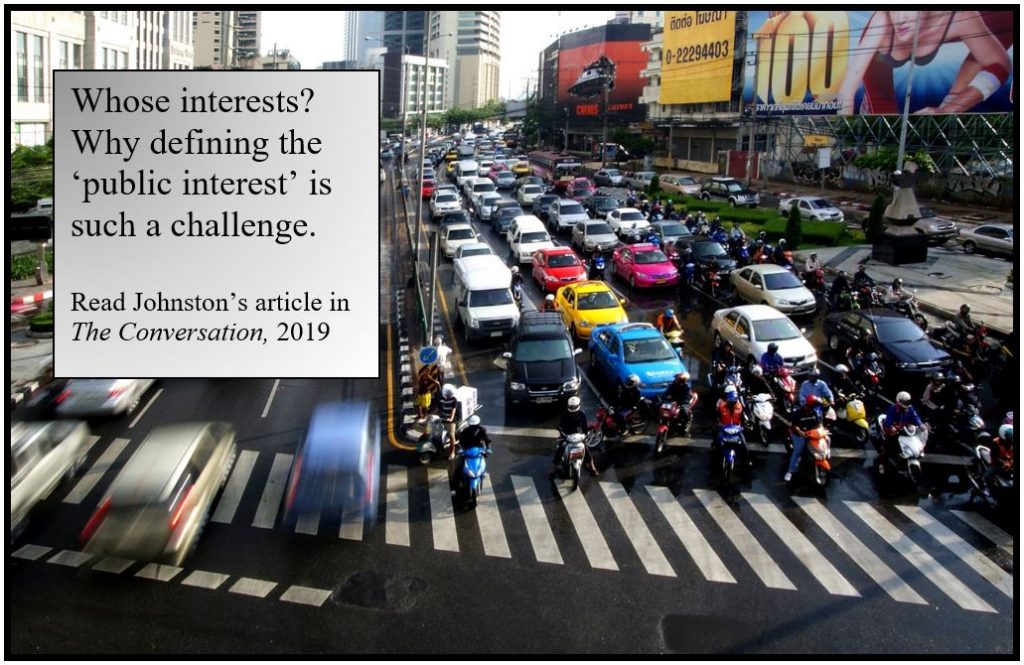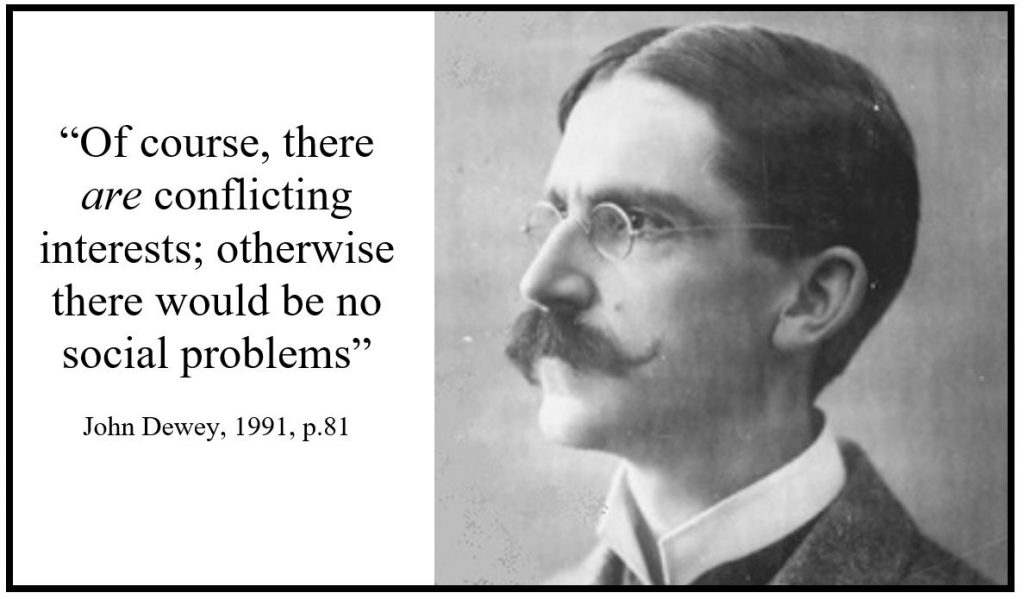1 What is the public interest?
Public interest communication: the foundations
Public Interest Communication is a developing field which is gaining traction with all sorts of communication disciplines – public relations (PR), political communication, advocacy and activism, to name a few. It is fundamentally about finding ways to work through issues of social justice, manage public problems, and enable public debate, through inquiry and discovery. It calls on the communication industries to take charge of their own futures and choose ethical pathways with clear lines of governance and accountability. Recently, the World Public Relations Forum Global Alliance chose the theme ‘connecting with courage’ to describe how the profession might move into the future. Embedded in this was the importance of the public interest for PR and communication. It said:
- It takes courage to represent public interest, steer ethically and be conscientious.
- The courage to adapt, have an understanding of, and communicate across cultures.
- The courage to acknowledge the gaps in and evolve our professional capabilities.
- The courage to question our tried and tested approach, think ahead and be creative.
We think the theme of ‘courage’ is a good fit, because sometimes communication in the public interest requires difficult choices. The Global Alliance is in good company in including the public interest in its call to action. Leading public relations figure Harold Burson (2012) argued that “we who choose careers in public relations also have an implied obligation to what we call the public interest”. He said it was incumbent on the role of PR to reconcile employer goals with the public interest. “Yes, communications and establishing relationships are part of the mix, but the process must start with appropriate behaviour that serves the public interest.” Many others have also added their voice to this argument and throughout this book we will include their approaches. Reflecting this, in this book we draw ideas and concepts from a range of theoretical and practical fields – from public relations and communication, to sociology and political science.
US scholar Jasper Fessmann has examined the field of public interest communication, connecting it to strategic communication, PR, nonprofit communication and philanthropic communication. He defines the field as: “the development and implementation of science based, planned strategic communication campaigns with the main goal of achieving significant and sustained positive behavioural change on a public interest issue that transcends the particular interests of any single organisation” (2016, p. 16).
While we share some common ideas with Fessmann’s approach to public interest communication, particularly in its capacity to broaden the scope of public communication, we diverge from it in a number of ways. Rather than connecting or aligning public interest communication to any one field, discipline or even sector (such as nonprofit communication or PR) we view its application more broadly “as a way of thinking and doing” communication (Johnston, 2016, p. 203). We position stakeholders as the central focus of this theory and, in so doing, see it less associated with strategic communication which is often connected with organisational output-focussed goals.
Perhaps most significantly we depart from Fessmann’s approach by positioning public interest communication as rooted in public interest theory itself, complete with the tensions and messy realities that exist within modern political and social systems. This comes with the need for dialogue, debate and, sometimes, argument to make sure competing, diverse and minority interests are heard. Our application thus proposes that reflexivity, participation, inquiry and debate are needed to sort through and engage with the myriad of interests people hold and the complicated contexts in which these may converge or diverge.
As we introduce in the next chapter, public interest communication thus exists as part of a ‘dialectic‘ where it is as much about the process of debating and discussing interests and issues as it is about finding the best solution or outcome. We follow others, as noted later in this chapter, in choosing not to define public interest but rather to explore its various applications and manifestations in our social world. That said, perhaps after reading this book, you might like to workshop your own definition of public interest with your class? Early public interest scholar Frank Sorauf called it “the X factor, the imponderable and the unknown, in the political equation” (1957, p. 617). It is also described as a “useful”, “deserving”, “convenient”, “vital” and “deserving” in determining society’s welfare (see Johnston, 2016, pp: 3-4).
So what is ‘the public interest’ anyway?
First, let’s deal with the idea of a single public interest as understood by the term ‘the public interest’.
What’s more, the public interest is purposefully not defined so that it can be considered within different contexts and circumstances (Bozeman, 2007; Carter and Bouris, 2006, Wheeler, 2018). Its almost total lack of definition or operational meaning has remained a curiosity to scholars, in part due to the paradox this presents when considered alongside its pervasiveness and ubiquity within deliberative democracies, civil society, and as part of political discourse. Public policy scholar Barry Bozeman (2007) calls it a conundrum: “nearly everyone is convinced that the public interest is vital in public policy and governance, but there is little agreement as to exactly what it is” (p. 84).
This lack of definition therefore allows flexibility. So, for example, if you were arguing for public interest in reducing homelessness; or in banning horse racing; or in the competing public interests of private versus public schools, each of these would be considered specifically in the context in which you were arguing it. These same issues would likely look different across different cultures because public expectations will vary – and public interests need to be considered within the context of the value system held by the society in which they are based.

Likewise, public interests are understood to move and shift with changing social mores, as the following statement sums up:
‘…50 years ago it was assumed that there was a public interest in knowing that an MP was gay, but little or no public interest in whether he drove home drunk, hit his wife or furnished his house using wood from non-sustainable sources. Now, obviously, it’s the other way round. Society does—and should—constantly redefine what the public interest entails’. (Sparrow, 2012 in Elliott, 2012).
Flathman (1966) argued that the lack of definition of the public interest was irrelevant to its function: that it is simply part of political discourse. As such, it centres on public discussion about what matters and why. In law, it is formally set out. Indeed, the legal system is awash with references to the public interest. Wheeler (2018) cites mention of the ‘public interest’ in more than 250 separate pieces of legislation and over 50 regulations in Australia’s most populous state (New South Wales). Nevertheless, the Australian Law Reform Commission suggests how it is interpreted should be “broad and flexible”, further stating that “including a non-exhaustive list of public interest matters seems more helpful than a definition,” (ALRC, 2014).
Thus, while public interest has no conclusive meaning, “its descriptive meaning is found through reasoned discourse that attempts to relate to changeable community values and is open to listening to a range of community perspectives” (Johnston 2023). This in turn “performs a logic” (Flathman, 1966, p. 40) within the policy and legislative environments in which we live.
Despite its lack of definition, Wheeler (2018) suggests the following list can provide guidance for finding the public interest in any given situation:
- complying with applicable law;
- carrying out functions fairly and impartially;
- complying with the principles of procedural fairness/natural justice;
- acting reasonably;
- ensuring accountability and transparency;
- exposing corrupt conduct or serious maladministration;
- avoiding or properly managing private interests conflicting with official duties; and
- acting apolitically in the performance of official functions.
There are other ideas which can help our understanding of the public interest. Over many decades the concept has not only been used in public discourse, it has also been theorised on a global scale by scholars from diverse disciplines and fields of thought. Some see it for its communitarian potentials (i.e. in bringing people together); others for recognising pluralism and diversity (i.e. in acknowledging difference); yet others for its normative value (i.e. as in a common good); and still others as a pragmatic concept (i.e. in applying action to problems). During the lock-down periods during the Covid-19 pandemic there was evidence of different countries (and regions) displaying different public interest approaches — for example, some communities displayed more community values, while others were more individualised in their responses, with reactions varying to government directives, either more accepting or pushing back. No doubt each thought their response had public interest merit.
Finally, we can see different ‘takes’ on public interest when we consider different professional fields that incorporate ‘public interest’ into their work: for example, public interest journalism focuses on investigative journalism which seeks to expose wrong-doing, as described here in The Conversation, while public interest law is often used synonymously with ‘pro bono’ law, about making the legal services available to those with limited resources. Different professions have embraced the idea of public interest and applied it to their field, for example, there is some practice or scholarship in public policy and politics, law, media, accounting, anthropology, planning, and psychology (Johnston, 2017). Now, of course, we add communication and public relations to that list.
Public and private interests
Public and private interests
In further thinking about this, we could develop a public-private continuum using examples and concepts from the book. See, for example, how ‘enlightened self interest’, ‘the social contract’ and social enterprises incorporate aspects of public and private, community and individualism (covered in chapter 9). What these theories show us is that private interests can and do often overlap with public interests.
Public interest & fostering dialogue
Social and political problems are not easily or simply resolved. Leading theorist in this field, John Dewey, wrote: “Of course, there are conflicting interests; otherwise there would be no social problems” (1991, p. 81). Dewey’s comment flags the complexity of society which is made up of many interests, many publics, many problems and many conflicts.
Communication can play a major role in working through these complicated issues and scenarios. Somerville and Davidson (2018) illustrate this in their analysis of communication within “deeply divided societies”, such as Northern Ireland, finding one solution in the so-called ‘Partners and Communities Together’ (PACT) which brought together neighbourhood policing teams and local communities in a kind of “communicative ritual” (2018, p. 182). To work, such a ritual cannot be generated by authorities — it must have buy-in from all participants. In addition, there needs to be a willingness “to cede control of the dialogue and not fear the enactment of passionate disagreement” (Somerville and Davison, 2018, p. 187).

As communication scholar John Durham Peters (1999) says, communication is fundamentally political and ethical rather than simply semantic (meaning only about language). Questions must be asked: what were the social, historical, cultural and political contexts of the communication? And, how were public interests represented in them?
Conclusion
Just as public problems cannot be easily solved, public interest communication is not a ‘quick fix’. We see this regularly throughout this book, especially when we tackle complex or ‘wicked’ problems. Communication acts can help (re)solve problems, but they can also fail. While not a simple answer, public interest communication can provide a toolkit to help find and navigate strategies to work through difference, open communication channels and, hopefully, move society forward. In the following chapters we explore these themes in more detail.
A complex concept which is essentially about one idea or thesis being considered against an opposing idea or anti-thesis, ideally to reach a synthesis.

